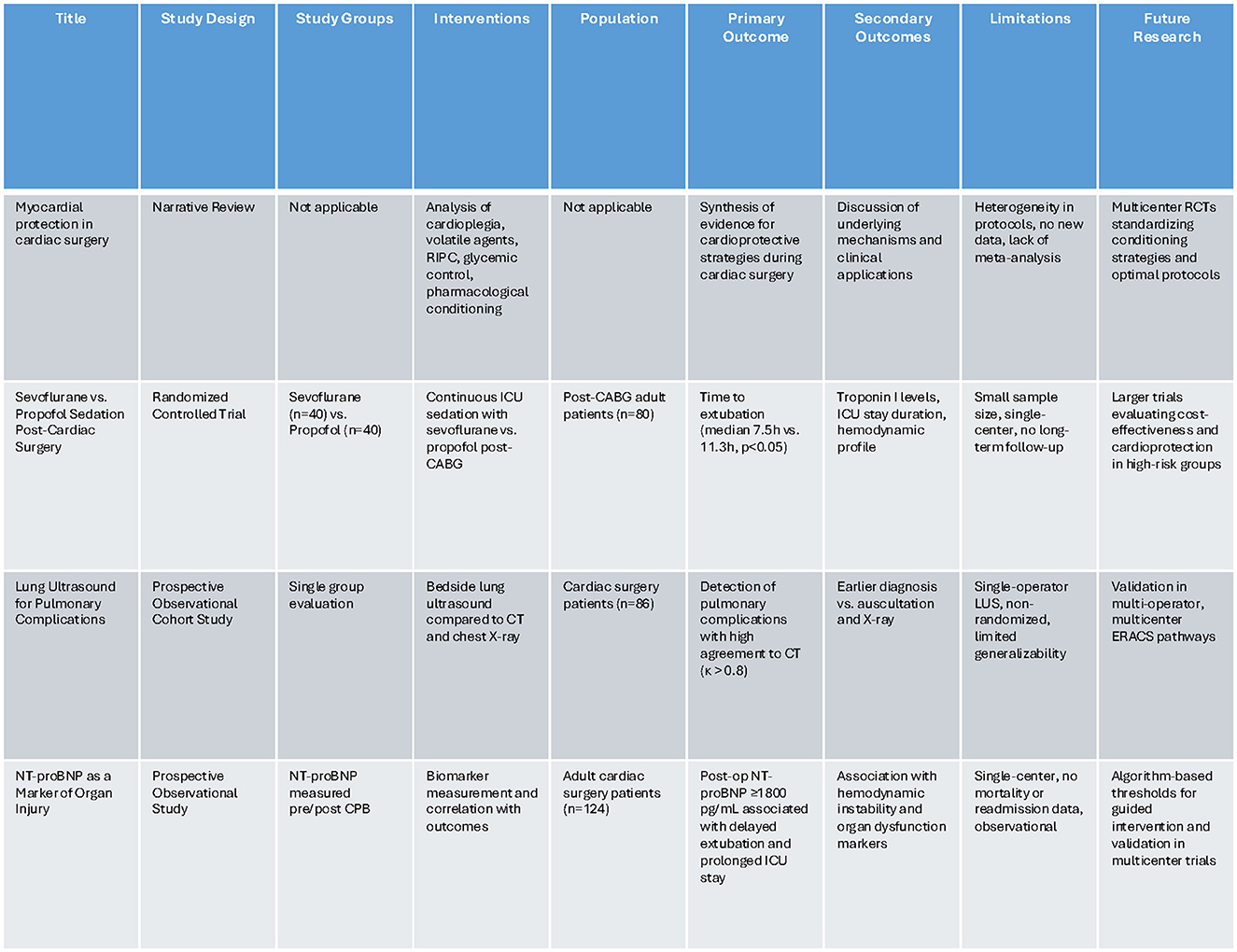- 1Cardiothoracic Anaesthesia and Surgical Intensive Care, Mansoura University, Mansoura, Egypt
- 2Cardiothoracic Anaesthesia, Imam Abdulrahman Bin Faisal University (formerly University of Dammam), Dammam, Saudi Arabia
- 3Department of Anesthesia and Critical Care, CHU Amiens, Amiens, France
- 4Laboratoire MP3CV, UR 7517, Université Picardie Jules Verne, Amiens, France
- 5Département d'Anesthésie-Réanimation, CHU Charles Nicolle, Rouen, France
- 6Faculté de Médecine et de Pharmacie, Université de Rouen, Rouen, France
- 7INSERM U1096 - EnVI, Rouen, France
- 8Intensive Care Committee, Société Française d'Anesthésie et de Réanimation (SFAR), Paris, France
Editorial on the Research Topic
Advances in cardiac anesthesiology and cardiopulmonary bypass for cardiac surgery and interventions
Introduction
Cardiac anesthesiology and perfusion medicine have undergone rapid transformation in recent years, reflecting the expanding complexity of surgical procedures and the growing need to individualize perioperative management. The interplay between anesthetic techniques, myocardial protection, extracorporeal circulation, and organ preservation has become increasingly important in defining short- and long-term outcomes in cardiac surgery.
In light of these evolving challenges and opportunities, we launched this Research Topic, “Advances in cardiac anesthesiology and cardiopulmonary bypass for cardiac surgery and interventions,” to provide a focused academic platform that brings together current perspectives, innovative techniques, and practical insights from around the world. The aim was to highlight perioperative strategies that optimize outcomes during cardiac surgical interventions—ranging from myocardial protection and monitoring to sedation strategies and organ-specific risk stratification.
The Research Topic received 15 submissions, and after a thorough peer review, four articles were accepted for publication. These studies reflect the diversity of research in our field and collectively provide timely contributions to clinical and research practice. Below, we summarize their key findings and outline future research directions. Figure 1 shows the strengths and limitations of these four studies.

Figure 1. A table compares four studies on cardiac surgery advancements. Columns include Title, Study Design, Study Groups, Interventions, Population, Primary Outcome, Secondary Outcomes, Limitations, and Future Research. Rows cover topics like myocardial protection, sedation techniques, lung ultrasound for complications, and NT-proBNP as a marker of organ injury. Each study is detailed with specific methodologies, outcomes, and suggestions for future research including larger trials and validation efforts. Limitations include small sample sizes and generalizability issues.
Conclusion and future research directives
This inaugural Research Topic underscores the evolving landscape of cardiac anesthesia and perfusion medicine. Each contribution highlights a critical component of perioperative care—ranging from myocardial protection to organ-specific diagnostics and sedation optimization. Notably, the articles emphasize the transition from empirical practice to precision-guided strategies based on objective markers and early diagnostic tools.
Moving forward, we encourage the cardiac anesthesia community to prioritize the following:
• Multicenter collaborations that bridge cardiovascular anesthesiology and surgical teams,
• Pragmatic trials that assess long-term outcomes and implementation feasibility,
• Integration of non-invasive monitoring (e.g., ultrasound, biomarkers) into enhanced recovery protocols,
• Translational research that connects molecular insights with bedside interventions.
We sincerely thank all authors, peer reviewers, and editorial staff for their contributions to this Research Topic. We hope this Research Topic serves as a springboard for continued innovation in perioperative care and a stimulus for broader engagement across surgical, perfusion, and critical care disciplines.
Author contributions
ME: Writing – review & editing, Writing – original draft, Conceptualization, Data curation, Validation, Project administration. OA-A: Validation, Supervision, Writing – review & editing, Writing – original draft. EB: Validation, Writing – original draft, Writing – review & editing, Supervision.
Conflict of interest
The authors declare that the research was conducted in the absence of any commercial or financial relationships that could be construed as a potential conflict of interest.
The author(s) declared that they were an editorial board member of Frontiers, at the time of submission. This had no impact on the peer review process and the final decision.
Generative AI statement
The author(s) declare that Gen AI was used in the creation of this manuscript. The author(s) verify and take full responsibility for the use of generative AI in the preparation of this manuscript. Generative AI was used exclusively for language refinement, formatting assistance, and figure layout design under direct human supervision. All intellectual content, critical interpretation, and final decisions remain the responsibility of the author(s).
Publisher's note
All claims expressed in this article are solely those of the authors and do not necessarily represent those of their affiliated organizations, or those of the publisher, the editors and the reviewers. Any product that may be evaluated in this article, or claim that may be made by its manufacturer, is not guaranteed or endorsed by the publisher.
Keywords: anesthesia, cardiac, cardiopulmonary bypass, myocardial protection, dexmedetomidine, lung ultrasonography, biomarkers
Citation: El Tahan MR, Abou-Arab O and Besnier E (2025) Editorial: Advances in cardiac anesthesiology and cardiopulmonary bypass for cardiac surgery and interventions. Front. Med. 12:1649654. doi: 10.3389/fmed.2025.1649654
Received: 18 June 2025; Accepted: 03 July 2025;
Published: 18 July 2025.
Edited and reviewed by: Zhongheng Zhang, Sir Run Run Shaw Hospital, China
Copyright © 2025 El Tahan, Abou-Arab and Besnier. This is an open-access article distributed under the terms of the Creative Commons Attribution License (CC BY). The use, distribution or reproduction in other forums is permitted, provided the original author(s) and the copyright owner(s) are credited and that the original publication in this journal is cited, in accordance with accepted academic practice. No use, distribution or reproduction is permitted which does not comply with these terms.
*Correspondence: Mohamed R. El Tahan, bW9oYW1lZHJlZmFhdGVsdGFoYW5AeWFob28uY29t
 Mohamed R. El Tahan
Mohamed R. El Tahan Osama Abou-Arab
Osama Abou-Arab Emmanuel Besnier
Emmanuel Besnier